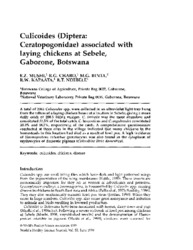| dc.contributor.author | Mushi, E. Z. | |
| dc.contributor.author | Chabo, R. G. | |
| dc.contributor.author | Kapaata, R. W. | |
| dc.contributor.author | Ndebele, R. T. | |
| dc.date.accessioned | 2022-05-05T07:43:26Z | |
| dc.date.available | 2022-05-05T07:43:26Z | |
| dc.date.issued | 2007-09-18 | |
| dc.identifier.citation | Mushi, E. Z., Chabo, R. G., Binta, M. G., Kapaata, R. W., & Ndebele, R. T. (1999). Culicoides (Diptera: Ceratopogonidae) associated with laying chickens at Sebele, Gaborone, Botswana. World's Poultry Science Journal, 55(2), 199-202 | en_US |
| dc.identifier.uri | https://doi.org/10.1079/WPS19990014 | |
| dc.identifier.uri | https://hdl.handle.net/13049/437 | |
| dc.description.abstract | A total of 2083 Culicoides spp. were collected in an ultraviolet light trap hung from the rafters of a laying chicken house at a location in Sebele, giving a mean daily catch of 208.3 biting midges. C. imicola was the most abundant and constituted 57.5% of the total catch. C. leucosticus and C. engubandei constituted 20.5% and 14.770, respectively, of the catch. A comprehensive questionnaire conducted at three sites in the village indicated that many chickens in the homesteads in this location had died as a result of fowl pox. A high incidence of Haemoproteus columbae gametocytes was also found in the cytoplasm of erythrocytes of domestic pigeons (Colurnbiae livia domestica). | en_US |
| dc.language.iso | en | en_US |
| dc.publisher | Cambridge University Press | en_US |
| dc.relation.ispartofseries | World's Poultry Science Journal;55(2), 199-202 | |
| dc.subject | Chickens | en_US |
| dc.subject | Disease | en_US |
| dc.subject | Colicoides | en_US |
| dc.title | Culicoides (Diptera: Ceratopogonidae) associated with laying chickens at Sebele, Gaborone, Botswana. | en_US |
| dc.type | Article | en_US |

